The Inside Outside Guys: Sound Advice
By Ken Calverley and Chuck Breidenstein
DETROIT, August 12, 2021 ~Years ago, the Inside Guy received a call from a custom home builder seeking some advice. It seems a customer was having humidity related issues in a laundry room and master bathroom.
The builder had done as she should have by installing larger capacity exhaust fans in both spaces.
The problem we discovered was that the fans were so noisy, the homeowner did not like using them.
Our solution? Install low sone fans and wire them to the main light switch in each space. The occupant will turn them on without knowing and the quiet fan will not bother them. Problem solved!
A sone rating is a linear index of “noise” with 1 sone roughly equal to the sound of a quiet refrigerator.
You can purchase bath fans today with ratings as low as .3 – three times more quiet than that appliance!
Noise issues are a first world “problem,” but they are real for those experiencing them. New homes built next to I-275 or a home proximate to a commercial venue with live entertainment can make life difficult.
Building materials have a Sound Transmission Class, or STC, rating indicating, on a comparative basis, how well a material or assembly reduces sound. The higher the rating, the more effective the reduction.
An STC of 25 for a wall assembly would represent hearing normal speech through it whereas a rating of 50 would indicate loud sounds that are only faintly heard through the wall.
But STC ratings are not linear, so an STC 50 may be more than twice as effective as an STC 25.
A standard wood frame wall partition with fiberglass batts in the cavities and ½” drywall on either side would have an STC assembly rating of 39.
Effective ways to reduce sound transmission is to “break” the waves or absorb them. In a typical wood frame wall, the sound waves may be partially absorbed by thermal insulating materials between the studs, but the wood siding and the studs themselves transmit the sound waves through to the drywall.
Open cell foam, mineral wool and cellulose insulation are all good sound absorbers. These products will have a Noise Reduction Coefficient, NRC, rating between 0 and 1 with 0 indicating perfect reflection of sound and 1 indicating perfect absorption of sound. So an NRC of .75 would indicate 75% sound absorption.
Gasket materials like those used for weather stripping can also help when used between pieces of framing materials as can sheet products such as Homasote, made from pressed cellulose, or Styrofoam used below drywall or siding.
Resilient metal channels can be used between studs and drywall finishes to reduce sound transmission and the drywall industry is experimenting with ever better sound absorptive product.
You may have noticed that an asphalt paved section of roadway, which absorbs more sound, is quieter than a concrete paved section, which reflects more sound. At 70 mph, the difference can be startling.
In a wood frame wall, we can “break” the waves by using split plates and staggered wall studs such that the wood from one side of the wall cannot transmit to the other side of the wall because they do not touch.
Keep in mind that the floor is also a transmitter as are metal fasteners in the assembly. Using glues in place of typical fasteners can help, and floor frames and floor sheathing can be “broken” during construction to limit transmission. Using this “isolation” technique with advanced assemblies, we can build “sound-proof” rooms.
We’ve discovered that homes built with “mass” walls and floors like concrete will be quieter. Cementitious products like Wonderboard, Durock or Hardibacker can be effective on wood frames below finish materials. Cement board products like James Hardie siding can reduce sound transmission through exterior walls.
There are also mas- loaded vinyl underlayments available for floors. This might be used above the theater room or the loud neighbor below your condo.
For more housing advice, listen to “The Inside Outside Guys“ every Saturday and Sunday on News / Talk 760 WJR from 10 a.m. to noon or contact us at InsideOutsideGuys.com.

